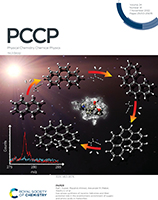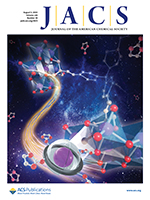Molecular-beam experiments with isomer-selective photoionization via a targeted, vinylacetylene-mediated gas-phase reaction of aromatic helicenyl radicals coupled with electronic structure calculations and astrochemical modeling reveal an elegant synthetic route to racemic helicenes – ortho-fused polycyclic aromatic hydrocarbons (PAHs), in which benzene building blocks form helically-shaped molecules. Read more »
Watching Nanoparticle Chemistry and Structure Evolve
Using a multimodal approach, researchers learned how chemical properties correlate with structural changes during nanoparticle growth. The work will enable a greater understanding of the mechanisms affecting the durability of nanoparticles used to catalyze a broad range of chemical reactions, including clean-energy reactions. Read more »![]()
![]()
Distinguishing Nanoparticles from Gas-Phase Species in Reacting Flows
Researchers developed a strategy for distinguishing between gas-phase species and newly formed nanoparticles in mixed gas- and particle-phase reacting flows. The approach uses small-angle x-ray scattering to study particle formation as it occurs by explicitly accounting for temperature-dependent scattering from gases. Read more »![]()
Optical sensing of aqueous nitrate anion by a platinum(II) triimine salt based solid state material
Researchers present a new Pt(II) salt that enables the selective and quantitative measurement of aqueous nitrate anions without the need for pH adjustment. The method relies on the color change of the Pt(II) complex from yellow to red and an intense luminescence response, simplifying the detection process for on-site applications and expanding its applicability to broader matrices. Read more »
Valence tautomerism in a cobalt-verdazyl coordination compound
Valence tautomerization in inorganic chemistry typically involves the distribution of electrons between a metal center and redox active ligand, with potential application as molecular switches or other molecular devices. Here we report an example of valence tautomerization and an unusual electronic structure in a cobalt verdazyl complex. Read more »
A New Material System for Mixed-Plastic Recycling
Scientists have designed a new material system to overcome one of the biggest challenges in recycling consumer products: mixed-plastic recycling. Their achievement will help enable a much broader range of fully recyclable plastic products and brings into reach an efficient circular economy for durable goods like automobiles. Read more »
Highly Selective Methane to Methanol Conversion on Inverse SnO2/Cu2O/Cu(111) Catalysts: Unique Properties of SnO2 Nanostructures and the Inhibition of the Direct Oxidative Combustion of Methane
Inverse catalysts generally consist of oxide nanoparticles supported on metal substrates, which can exhibit exceptional catalytic properties. The small SnO2 nanoparticles uniformly dispersed on a Cu2O/Cu(111) substrate enabled a unique SnO2–Cu2O interface that can completely convert methane to methanol directly under the environments of oxygen and water. Read more »
Scientists Grow Lead-Free Solar Material With a Built-In Switch
A new ferroelectric material—grown in the lab from cesium germanium tribromide (CGB)—opens the door to an easier approach to making solar cell devices. Unlike conventional solar materials, CGB crystals are inherently polarized, where one side of the crystal builds up positive charges and the other side builds up negative charges, no doping required. Read more »
Ionic Conduction Mechanism and Design of Metal–Organic Framework Based Quasi-Solid-State Electrolytes
This cover image demonstrates the critical role of the solvent in the ion motion of intrinsically anionic metal–organic framework (MOF)–based quasi-solid-state electrolytes (QSSEs). Using hybrid theoretical and experimental approaches, we have identified solvent-assisted hopping as the dominant pathway for Li+ conduction in such materials, exemplified by MOF-688. Read more »
Hybrid Semiconductors Perform Under Pressure
Researchers found that compressing hybrid (organic–inorganic) semiconductors significantly boosts their conductivity. The work demonstrates a novel doping mechanism in which the material’s organic molecules serve as charge reservoirs for tuning charge-carrier concentration, with promising applications in solar cells, lasers, and LEDs. Read more »![]()
![]()
- « Previous Page
- 1
- 2
- 3
- 4
- 5
- 6
- …
- 13
- Next Page »









